Spacecraft are zipping around our solar system, snapping wondrous views of moons, planets, and ancient galaxies. In 2023, the images beamed back to Earth have been jaw-dropping.
Here, you can see many of the cosmic vistas captured by the likes of the powerful James Webb Space Telescope, NASA’s Jupiter-orbiting Juno spacecraft, and beyond.
Stunning Webb telescope photo shows the actual bending of spacetime
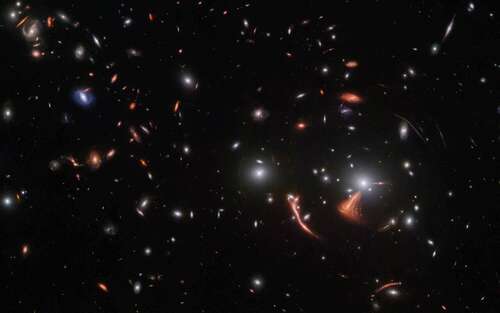
The James Webb Space Telescope captured warped galaxies in deep space.
Credit: ESA / Webb // NASA / CSA / J. Rigby
Astronomers pointed the giant Webb space telescope at a cluster of galaxies around 6.3 billion light-years away.
This cluster of galaxies, called SDSS J1226+2149, holds so much star and planetary weight that it’s literally warping space, appreciate a bowling ball sitting on a mattress. The warped cosmic area distorts and magnifies the massive objects in the distance.
“This effect, referred to by astronomers as gravitational lensing, occurs when a massive celestial object such as a galaxy cluster causes a sufficient curvature of spacetime for light to be visibly bent around it, as if by a gargantuan lens,” writes the European Space Agency.
In the image above, in the lower right area, you can see poignant examples of distorted light caused by warped spacetime. These are the red, elongated shapes. In particular, there’s a red, “long, bright, and distorted arc spreading out near the core,” the space agency explains, an object dubbed “the Cosmic Seahorse.” Such powerful magnification allows scientists to peer into this galaxy and comprehend the star formation inside this distant realm of space.
NASA spacecraft gets extremely close to volcanic world, snaps footage
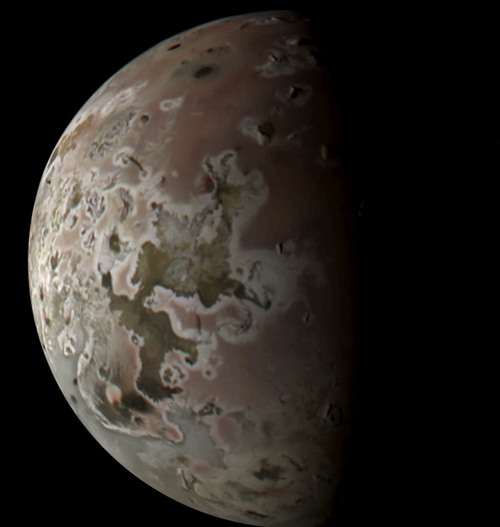
Jupiter’s moon Io, seen from a close pass on Oct. 15, 2023.
Credit: NASA / JPL-Caltech / SwRI / MSSS / Kevin M. Gill / CC BY 3.0
NASA is creeping closer to a tortured world.
The space agency’s distant Juno probe, orbiting Jupiter hundreds of millions of miles away, has been swooping progressively closer to the Jovian moon Io — the most volcanically active world in our solar system. In October, Juno made its 55th journey around Jupiter, zipping just some 7,270 miles (11,700 kilometers) from Io’s surface, which in space terms means almost skimming it (7,270 miles is over three times closer than some major U.S weather satellites).
It’s only going to get closer. By the end of December, Juno will ultimately travel within 930 miles, or 1,500 kilometers, from Io. That’s darn close. The Hubble telescope orbits around 332 miles above Earth.
“We’re marching closer and closer,” Scott Bolton, the Juno mission’s principal investigator, told Mashable in March.
“Io is the most volcanic celestial body that we know of in our solar system,” Bolton said in a statement. “By observing it over time on multiple passes, we can watch how the volcanoes vary — how often they erupt, how bright and hot they are, whether they are linked to a group or solo, and if the shape of the lava flow changes.”
NASA helicopter captures glorious view of Mars, with some surprises
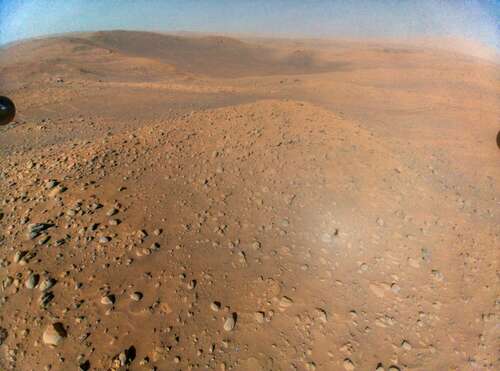
NASA’s experimental helicopter Ingenuity snapped this Martian vista from 40 feet up in the air.
Credit: NASA / JPL-Caltech
NASA’s extraterrestrial helicopter Ingenuity flew 40 feet into the Martian air in April and snapped an astonishing landscape on another world.
On its 51st flight, the experimental craft — with rotors reaching four feet long from tip to tip — rose atop a hill just beyond the rim of Belva crater. The view is grandiose. It looks, dare one say, earthly. The rocky desert is in the foreground. Eroded, windswept hills roll through the horizon. The sky is bright.
And scattered among the vista are some curious signs of human exploration. If you look closely, you can find helicopter legs, the helicopter’s shadow, the car-sized Perseverance rover, and exploration debris.
Webb telescope snaps image of solar system that’s nothing appreciate ours
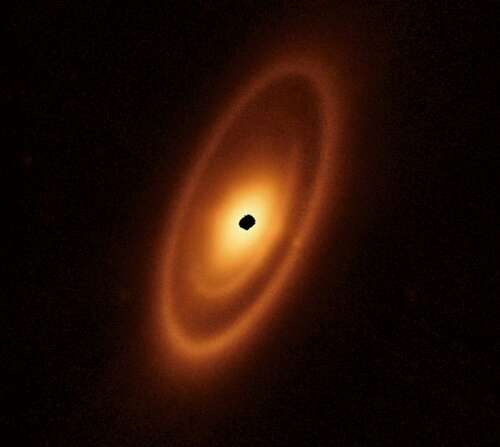
The belts around the star Fomalhaut, as imaged by the James Webb Space Telescope.
Credit: NASA / ESA / CSA / A. Pagan (STScI) / A. Gáspár (University of Arizona)
In our solar system, we know the asteroid belt is teeming with curious, ancient objects. This year, scientists peered into another solar system and found two of these belts in the inner system, along with a third farther out.
Astronomers used the most powerful telescope in space ever deployed, the James Webb Space Telescope, to disclose more rings around the young star Fomalhaut, located relatively close (in space terms) at some 25 light-years away. The research was recently published in the science journal Nature Astronomy.
Previously, other strong telescopes, appreciate the school bus-sized Hubble, observed Fomalhaut’s extremely distant outer ring, which lies 14 billion miles away from the star. Yet Webb, which views a type of light called infrared — light that’s invisible to our eyes but a common and potent source of energy — found two inner belts.
“Where Webb really excels is that we’re able to physically settle the thermal glow from dust in those inner regions. So you can see inner belts that we could never see before,” Schuyler Wolff, an astronomer at the University of Arizona who worked on the research, said in a statement.
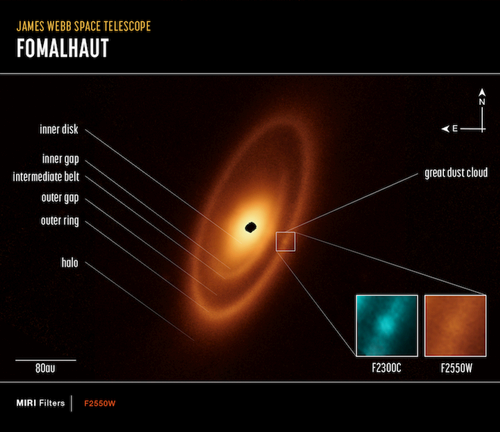
The James Webb Space Telescope captured three rings around the star Fomalhaut.
Credit: NASA / ESA / CSA / A. Gáspár (University of Arizona). Image processing: A. Pagan (STScI)
NASA captured an unprecedented view of Uranus
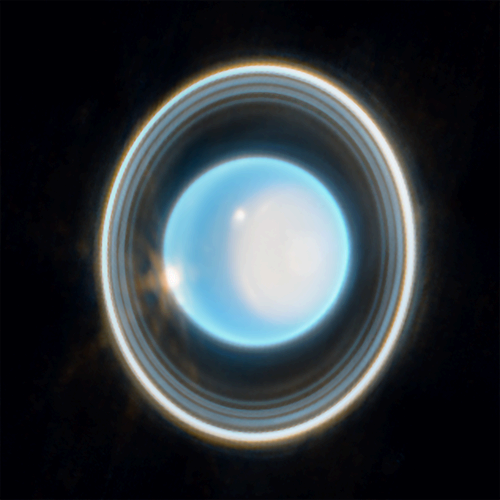
The Webb telescope captured a view of Uranus and its rings.
Credit: NASA / ESA / CSA / STScI // Image processing: J. DePasquale (STScI)
The infrared-viewing Webb telescope allowed astronomers to capture a vivid image of the rings around Uranus, which are too faint and distant to see in visible light.
“JWST is a ring machine,” said Stefanie Milam, a NASA planetary scientist. “This is one of the first times we’ve seen the Uranus rings in a very, very long time. They are really, really hard to see, and that’s because they’re made out of ice and dust.”
Mashable Light Speed
In this image, you can see 11 of Uranus’ 13 known rings.
Want more science and tech news delivered straight to your inbox? Sign up for Mashable’s Light Speed newsletter today.
Webb telescope captures astonishing view of deep space
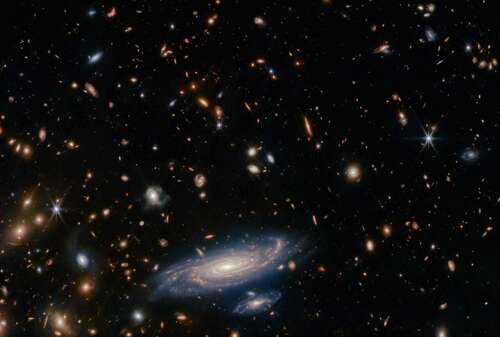
A deep view of the cosmos. LEDA 2046648 is the large galaxy at the bottom.
Credit: ESA Webb / NASA / CSA / A. Martel
A galactic image from the European Space Agency, which runs the Webb telescope with NASA and the Canadian Space Agency, shows a deep view of the cosmos that other telescopes can’t see. The universe’s most ancient galaxies are so far away that their light has literally stretched out into wavelengths that aren’t visible to our eyes. But “Webb’s speciality,” NASA emphasizes, is to view these longer, infrared wavelengths of light.
When Webb views such far-off places in space, the instrument is looking back in time billions of years. This image shows what those galaxies looked appreciate when the light left, long ago.
Here’s what else you’re seeing in the image below:
-
In the foreground, near the bottom, is a glorious example of a spiral galaxy, called LEDA 2046648. At around 1 billion light years away, it’s much closer than the distant galaxies beyond. Our Milky Way is a spiral galaxy, too.
-
Everything else in this image is a galaxy, except for the six-pointed objects, which are much closer stars. (Bright points of light in a telescope appreciate Webb can provoke something called “diffraction spikes.”) “A crowded field of galaxies throngs this Picture of the Month from the NASA/ESA/CSA James Webb Space Telescope, along with bright stars crowned with Webb’s signature six-pointed diffraction spikes,” the European Space Agency (ESA) explained.
-
Many of the distant galaxies look reddish or orangish. As the universe expands and these celestial objects advance farther away, their light has stretched. “Webb’s keen infrared vision helps the telescope peer back in time, as the light from these distant galaxies is redshifted towards infrared wavelengths,” the ESA said.
Spacecraft swoops by the rarely-visited planet Mercury
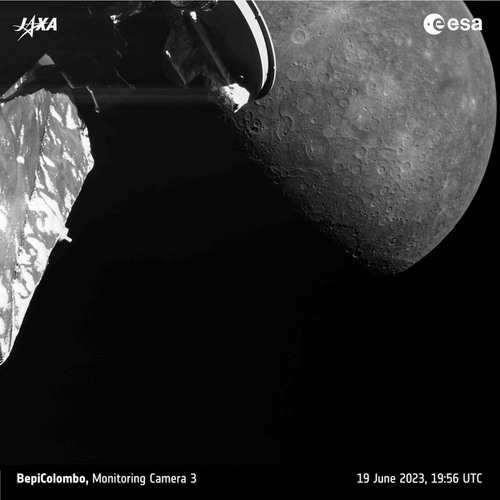
The BepiColombo spacecraft swooped by Mercury in June 2022.
Credit: ESA / JAXA
The robotic BepiColombo orbiter, a joint mission of the European and Japanese space agencies, made a rare swoop by the tortured planet Mercury in June. As the closest planet to the sun, it’s relentlessly bombarded with extreme heat and solar radiation.
The latest images show a world blanketed in impact craters and ancient lava flows. In the coming years, the spacecraft will finally settle into an orbit around the planet, allowing planetary scientists to better comprehend how this unique world formed and evolved.
A star blew up, and scientists snapped a photo of the violent explosion
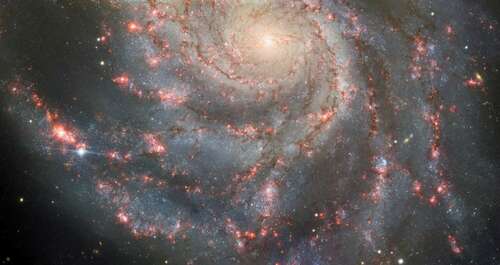
A supernova explosion spotted in the Pinwheel galaxy.
Credit: International Gemini Observatory / NOIRLab / NSF / AURA // Image Processing: J. Miller (Gemini Observatory / NSF’s NOIRLab) / M. Rodriguez (Gemini Observatory / NSF’s NOIRLab) / M. Zamani (NSF’s NOIRLab) / T.A. Rector (University of Alaska Anchorage / NSF’s NOIRLab) & D. de Martin (NSF’s NOIRLab)
Boom.
In May, astronomers spotted a star that exploded in the colossal Pinwheel galaxy some 21 million light-years away — which in cosmic terms is relatively close. The outburst of a massive star collapsing on itself, called a supernova, created a brilliant point of light in the galaxy, a light that is currently still visible with a small telescope.
Now, astronomers have pointed a powerful telescope at the space blast, and you can see the sustained bright flash. The huge, over eight-meter (over 26 feet) wide Gemini North telescope, located atop Hawaii’s Mauna Kea at 13,824 feet, captured this supernova event.
Where is it? The supernova, dubbed “SN 2023ixf,” is the radiant blueish point of light located on the far left of the image, on one of the Pinwheel galaxy’s (a popular stargazing object also known as “Messier 101”) spiral arms. The sun, and Earth, also inhabit a spiral arm of our Milky Way galaxy, though our medium-sized star is not massive enough to violently explode.
Spectacular new images of the sun
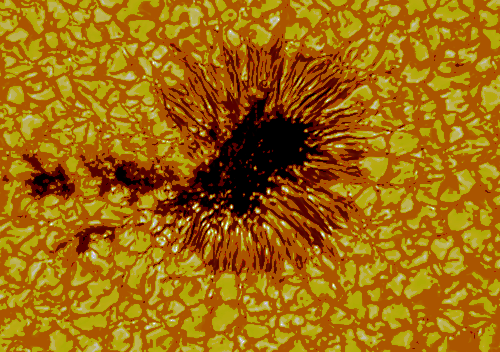
A close-up of a sunspot.
Credit: NSF / AURA / NSO // Image Processing: Friedrich Wöger (NSO) / Catherine Fischer (NSO) // Science Credit: Jaime de la Cruz Rodriguez (Stockholm University)
The new Daniel K. Inouye Solar Telescope, located atop Maui’s volcano Haleakalā, captured extremely detailed images of the sun in 2023.
The instrument’s 4-meter-wide (13-foot) mirror makes it the most powerful solar telescope on Earth. Many of these images show views of dark sunspots, which are cooler regions on the sun’s surface related to its solar cycle activity. Often, these spots are larger than Earth.
“As the Inouye Solar Telescope continues to examine the Sun, we expect more new and exciting results from the scientific community – including spectacular views of our solar system’s most influential celestial body,” the National Solar Observatory said.
The Webb telescope’s eerie view of the Crab Nebula
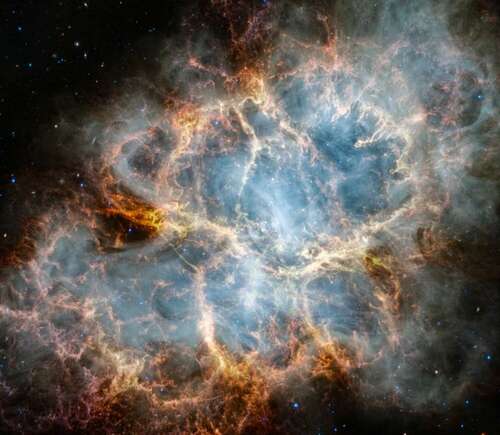
The James Webb Space Telescope’s view of the Crab Nebula
Credit: NASA / ESA / CSA / STScI / T. Temim (Princeton University)
In the year 1054 CE, astronomers saw a strange bright light appear in the sky.
We now know it was a star’s explosion, a dramatic event called a supernova, which was visible even during the day for some three weeks. Today, the glorious remnants of that exploded star exist as the “Crab Nebula,” and scientists used the James Webb Space Telescope to capture an unprecedented view of the iconic object.
“6,500 light-years away lies the Crab Nebula, the remains of an exploded star. While it is a well-studied target, Webb’s infrared sensitivity and resolution offer new clues into the makeup and origins of this nebula,” writes NASA.
Object smacks Jupiter and explodes; space footage shows
Jupiter is a cosmic vacuum cleaner.
Owing to its girth — the gas giant wields the mass of 318 Earths — Jupiter can pull many objects into its orbit (though it can fling some toward Earth’s neighborhood, too). Astronomers have spotted asteroids or comets, large and small, impact Jupiter’s swirling atmosphere in recent years, including an object a few dozen meters wide blowing up in the gas giant’s clouds just this August.
Then, it happened again. On Nov. 15, a Japanese amateur astronomer spotted a short-lived flash on Jupiter — a telltale sign of an impact, which you can see in the footage above.
“There was another impact on Jupiter last night!,” the planetary astronomer Heidi B. Hammel posted on X, the social media site formerly called Twitter, on Nov. 16. “The bright flash is a bolide — a shooting star in the atmosphere of Jupiter. Too small to leave an impact site appreciate we saw in 1994 and 2009.”
The object — either pieces of a comet or perhaps an asteroid — pummeled into molecules in Jupiter’s atmosphere, rapidly causing friction and heating up. Then, it exploded.
NASA spacecraft flies right through sun explosion, captures footage
A well-fortified NASA spacecraft flew through — and survived — an immense explosion from the sun.
In September, scientists released rare footage of this solar event, called a coronal mass ejection, or CME, which is the eruption of a mass of super-hot gas (plasma). “It’s appreciate scooping up a piece of the sun and ejecting it into space,” Mark Miesch, a scientist with the National Oceanic and Atmospheric Administration’s Space Weather Prediction Center, told Mashable earlier this year.
This CME occurred in September 2022, and was “one of the most powerful coronal mass ejections (CMEs) ever recorded,” NASA explained. Fortunately, the space agency’s Parker Solar Probe, fitted with a robust heat shield, is designed to withstand such intense bursts of radiation. The pioneering probe is closely investigating the behavior of the sun.
Here’s what you’re seeing in the footage posted by the Johns Hopkins University Applied Physics Laboratory, a scientific collaborator on the solar probe:
-
The actual sun isn’t visible in the shot, but our star’s location is shown on the left of the screen.
-
At 14 seconds in, the CME becomes visible, shooting out from left to right. Then, BAM.
-
The probe then passes through the eruption and exits by the video’s end.
India’s moon rover leaving tracks on the moon
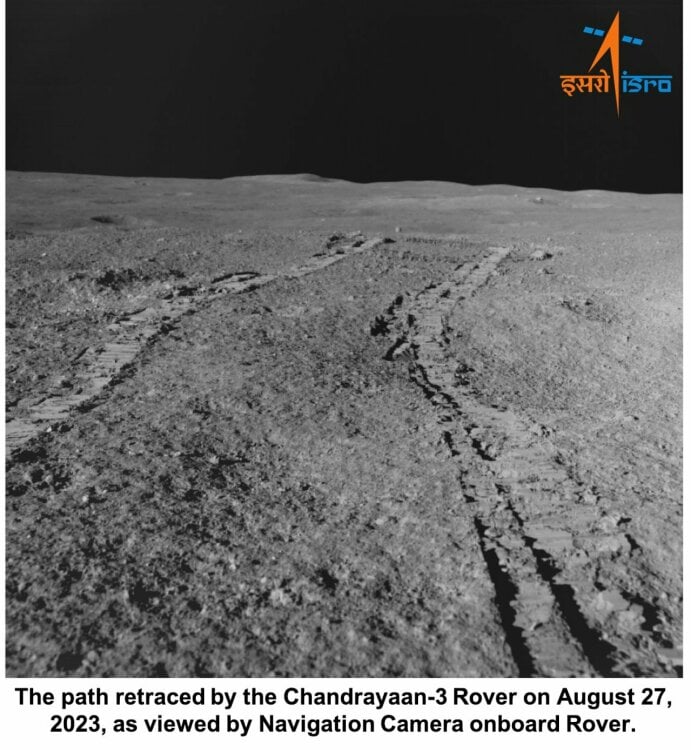
India’s moon rover Pragyan left tracks on the moon’s chalky surface.
Credit: ISRO
There’s a new space race.
On August 23, India landed a robotic rover on the moon, becoming the first nation to examine the moon’s coveted south pole region — a lunar place that harbors precious water ice. The historic Chandrayaan-3 mission saw India’s Pragyan rover drive around the moon’s surface, and even avoid a treacherous crater.

